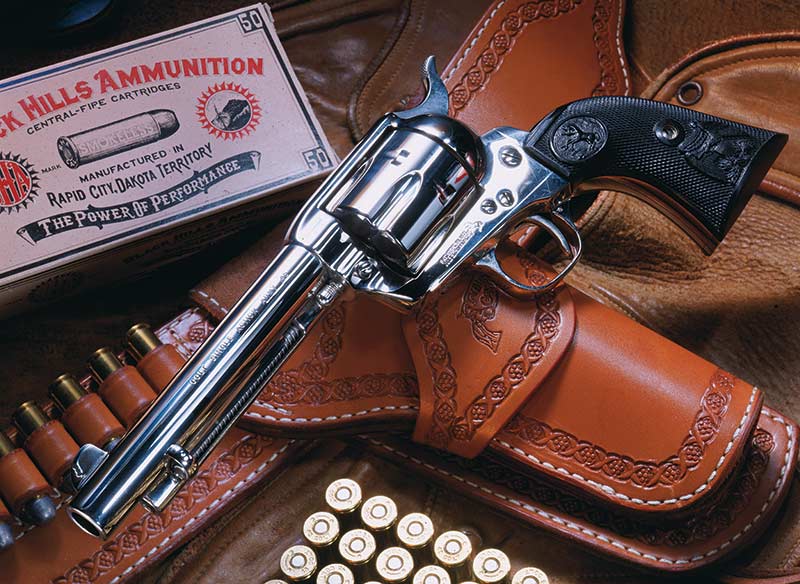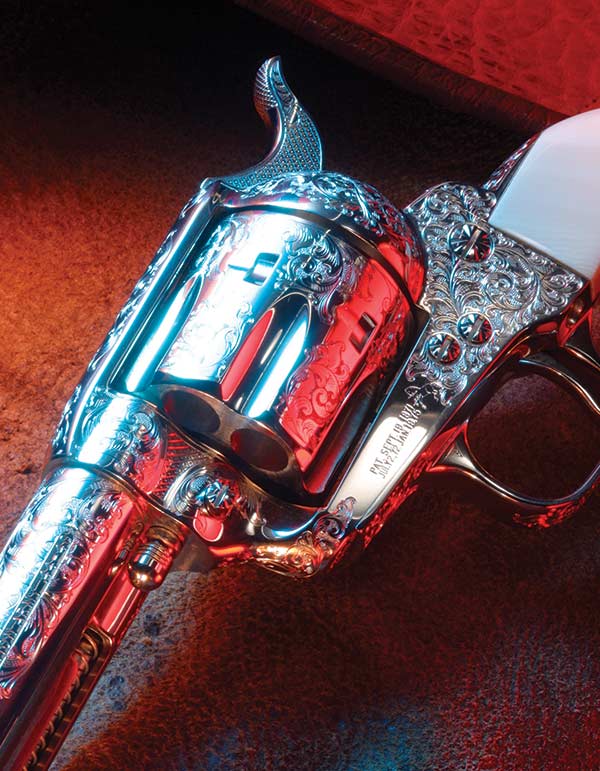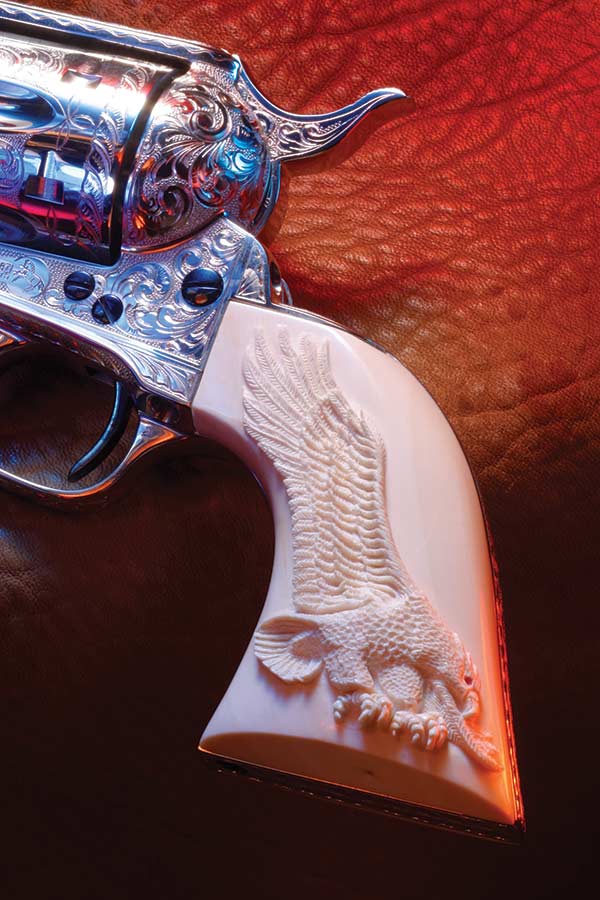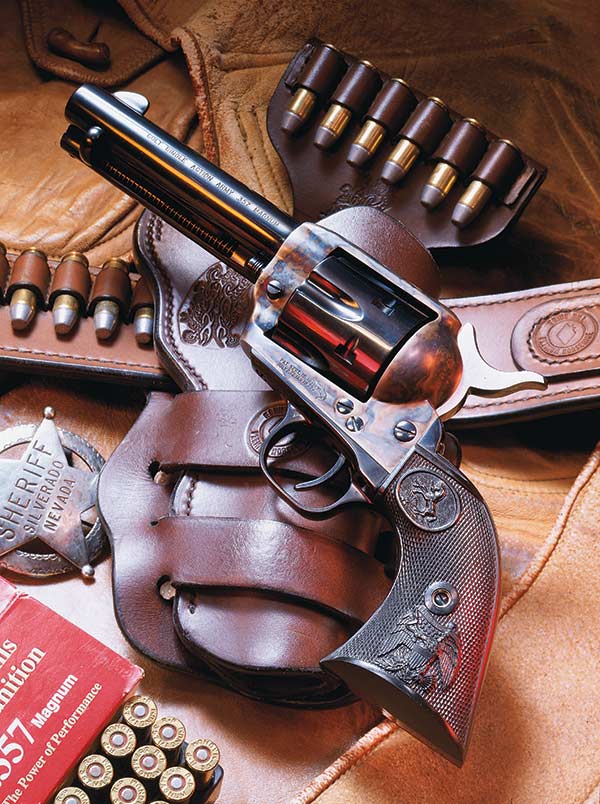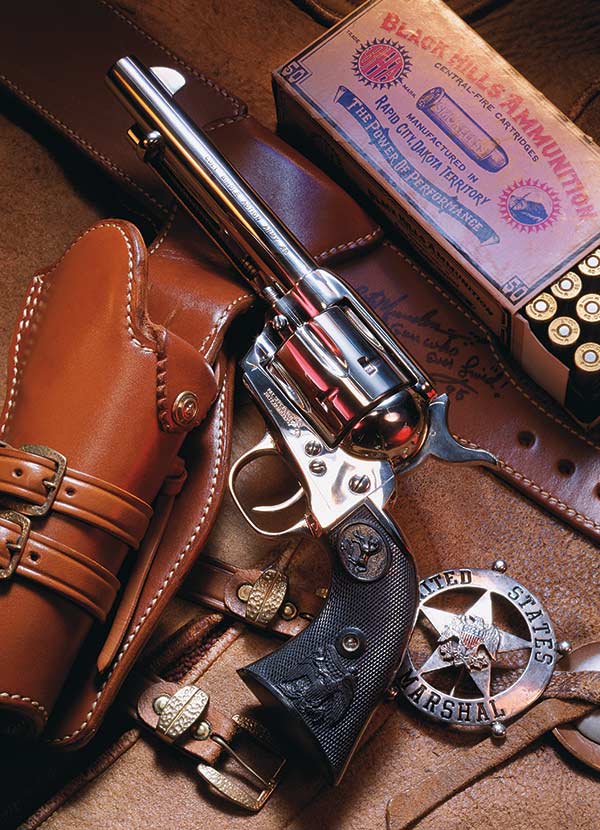The Single Action Army
An inventive mind is a wonderful human attribute, however it also requires intelligence and inspiration to function. For myself, it’s a waste of time to sit down to write unless I have been inspired. Inspiration might come from a piece of mail, a talk with one of my editors, a rare movie, a shooting session or some other source. For 16 year-old Samuel Colt, inspiration came in a very strange form. At this time in his life neither his ability to invent nor his intelligence had been shown to any great degree, how-ever inspiration lay before him.
Young Sam signed on as a cabin boy on the ship Corlo bound from Boston to Calcutta. In his spare time he noticed the ship’s wheel revolved and the spokes always came back into perfect alignment as it was locked by a clutch. Colt watched this operation and was inspired to carve a wooden pistol with a revolving cylinder.
The First Colt
Six years later at the mere age of 22, the first Colt, the Model 1836 Paterson arrived. Sam had shown his intelli-gence by searching out gunsmiths in Hartford during the years 1831-1832 to turn his wooden model and drawings into a working revolver.
The Paterson, so called because it came from a factory in Paterson, N.J., featured a rotating cylinder actuated by cocking the hammer, a locking bolt that unlocked as the hammer was cocked, and then re-locked as a cylinder rotated to the next firing position, and a trigger allowing the hammer to fall.
Every single-action revolver manufactured since 1836 which bears the name Colt, Remington, Ruger, Freedom Arms etc., owe their very existence to Colt’s first revolver. We might add here that the Paterson was not the first revolver to be made but was certainly the first truly usable and successful revolver.
However in 1847 another Sam, Capt. Samuel Walker of Texas convinced and inspired Colt to build another, better revolver. As he had no manufacturing facilities, Colt turned to Eli Whitney Jr. to do the actual manufacturing of the 1847 Walker. Colt was now on his way.
In 1848 the 1st Model Dragoon arrived and was rapidly followed by the 2nd and 3rd Models. All of these were huge .44 caliber sixguns weighing over four pounds. At the same time Colt also offered small .31 caliber pocket pistols such as the Baby Dragoon and Wells Fargo. Would it be possible to combine the two ideas and come up with a sixgun easier to carry than the Dragoons and yet more powerful than the diminutive pocket pistols?
Shape Of Things To Come
The result was the Model of 1851, the .36 Colt Navy. The gunfighter’s weapon had arrived. For the first time it was possible for the competent pistolero to be just as dangerous with his sixgun belted on as he was with it in his hand. The era following the Civil War would produce numerous gunfighters, however Colt had already produced the sixgun. The only task left was a continual refinement over the next 20 years.
The Model 1851 went big bore in 1860 with the .44 Army. This was the number one revolver supplied to the Union troops during the Civil War as well as the United States Cavalry as we pushed westward in the late 1860s.
While Colt built the best possible percussion revolvers, a young company by the name of Smith & Wesson introduced the first cartridge-firing revolver, a seven-shot .22, in 1857. Colt ignored it. Old Sam saw no future in cartridge-firing revolvers as he knew every sixgunner would always prefer to load their own powder and ball. By 1869, Sam Colt was dead, and S&W introduced the first big bore cartridge-firing sixgun, the Model No. 3 American, a six-shot, top-break, .44 caliber revolver.
Management at Colt was not only caught off guard, they found they could not produce a cartridge-firing revolver until Rollin White’s patent for a bored-through cylinder expired. Ironically, Colt had turned down White when he offered them first choice on his patent.
Colt did several things to get around the patent. There was the Thuer Conversion, which allowed a tapered cartridge to be inserted from the front of the cylinder. Then came the Richards Conversions and Richards-Mason Conversions on Model 1851 Navy and Model 1860 Army revolvers, and then as the patent ran out, Colt brought forth their first cartridge-firing sixgun with the 1871-1872 Open-Top. This was not a conversion but actually built from the factory to fire cartridges.
Genesis Of The Peacemaker
It was at about this same time the Army conducted tests to adopt a new revolver. Colt submitted their Open-Top. The Army sent Colt back to the drawing board with two sugges-tions. They wanted a solid-frame revolver and a caliber larger than the .44 Colt of the Open-Top.
The same Mason who lent his name to the Richards-Mason Conversion now went to work. Inspiration comes from many sources and I have to believe, or at least I choose to believe, that the result of William Mason’s work came supernaturally. The Colt Single Action Army that came from Mason’s drawing board is such a beautiful design and so different from anything Colt had produced up to that time that Mason surely needed extra inspiration to come up with it.
The original Colt SAA was designed for one purpose, to receive an Army contract. To this end they were produced in the 71⁄2-inch barrel length, which basically duplicates the bal-ance of the Model 1851 and Model 1860. From 1873 to 1891, Colt supplied slightly more than 37,000 Cavalry Model SAAs.
In 1877, the Colt Model P was chambered in .44-40 as a companion piece to the Winchester Model 1873 levergun. About this same time the first Colt Single Action Army with a 43⁄4-inch barrel was offered. The three standard barrel lengths are known as the Cavalry Model (71⁄2 inch), Artillery Model (51⁄2 inch), and Civilian Model (43⁄4 inch).
Holstergun Supreme
The latter is perhaps the most finely balanced sixgun in existence. In trained hands and from a properly designed holster, it cannot be beaten for that all-important first shot. It is at the top of the list of gunfighter’s weapons offered by Colt, Remington, and S&W during the second half of the 19th-century.
Over the next half-century the Colt Single Action Army would be carried by such famous and infamous men as Jesse James, Wyatt Earp, Doc Holliday, Bat Masterson, Bill Tilghman, Heck Thomas, Chris Madsen, John Wesley Hardin, and even Theodore Roosevelt during his ranching days in the Dakota Territory.
In 1916 a young officer who would become very famous in World War II — Army Lieutenant George Patton — pur-chased a fully engraved, nickel plated, ivory stocked, 43⁄4-inch .45 Colt SAA before joining Black Jack Pershing in the chase after Pancho Villa. Villa himself packed a nickel plated, ivory stocked, 43⁄4-inch .45 Colt.
Can we even begin to imagine Western movies without the Colt SAA? Saturday matinees for several generations of kids with William S. Hart, Buck Jones, Hopalong Cassidy, Wild Bill Elliott, Roy Rogers, and Gene Autry carrying something other than a Single Action Colt? Matt Dillon making the streets of Dodge City safe without a 71⁄2-inch Colt Peacemaker in his hands?
Death Of The Colt SAA?
From 1873 until 1941 nearly 358,000 Colt Model P six-guns were manufactured in more than 30 calibers. Approximately one-half of these were chambered in .45 Colt, one-fourth in .44-40, and followed in popularity by .38-40, .32-20, and .41 Long Colt.
After World War I shooters discovered other Colt hand-guns, the relatively new 1911 .45 ACP and the large-frame double action, the New Service. The popularity of S&W’s beautifully built DA revolvers in both .38 Special and .44 Special further dulled the appeal of the good old SAA.
The days of the Colt Single Action Army were numbered. The sixgun whose yearly production table often ran to five figures now had years with 100 units being made. In 1941 the inevitable happened and the Colt SAA was removed from production never to be seen again. Or so everyone thought.
By the early 1950s, television had spread across most of the country and many hours were filled by old Western B movies from the 1930s and 1940s. There were dozens of heroes galloping across the screen, however the real star of every one of these movies was the Colt SAA. Demand arose for Colts. Colt listened and in 1956, the 2nd Generation of Colt Single Actions arrived.
The original machinery for the 1st Generation was long gone and worn out anyway, so it required all-new machinery to produce the “new” Colt Single Action. The first chamberings were .45 Colt and .38 Special with the .44 Special and .357 Magnum added shortly. It would take less than 20 years for the new machinery to wear out and in 1974 the run of 2nd Generation Single Actions would end. The Colt Single Action was dead again, but not for long.
Two years later, the Colt Single Action resurfaced once again as the 3rd Generation run began. While the 1st and 2nd Generation Colts were nearly identical, several changes to cut costs were instituted with the 3rd Generation Single Actions.
The removable, full-length cylinder bushing was replaced by a press-fit, button collar bushing in the front of the cylinder. The ratchet design on the back of the cylinder and also the shape of the hand that engages the ratchet were both changed to cut down on the time required for hand fit-ting, and for some strange reason the barrel shank threads were changed from 20- to 24-tpi.
Sampling Current Production
The 3rd Generation Colts have been offered in .45 Colt, .44-40, .38-40, .44 Special, and .357 Magnum in the three standard barrel lengths as well as Buntline Special and short-barreled Sheriff’s Models in some calibers. Finishes are both blue and casehardened and nickel. Currently, Colt offers only 43⁄4 and 51⁄2-inch versions in either finish and chambered in .45 Colt, .44-40, and .357 Magnum. Furnished test guns for this article were a 51⁄2-inch, nickel-plated .45 Colt, and a 43⁄4-inch, blued and casehardened .357 Magnum.
Both of these current production guns are beautifully finished, tightly fitted with virtually no cylinder end play or side-to-side movement, and both came with trigger pulls in excess of five pounds. For my test firing sessions a thick padded washer cut from leather was placed under the main-spring to lessen both trigger pull and cocking effort.
To ensure a good-shooting sixgun, cylinder throat diameter must be held to the correct tolerances. The .45 SAA test gun came with throats that measured out at .4555 inch. I would like to see Colt hold this to no more than .453 inch. I used .454-inch bullets in much of my testing, and with the RCBS No. 45-270, sized to this diameter and weighing in at 281 grains, accuracy was exceptional, although this load shoots about one inch above point of aim. Muzzle velocity is 933 fps, and it would be hard to find a better everyday working load and sixgun combination than this.
A caution is warranted concerning .45 Colt throat diameters. I just watched Larry Crow’s video on Customizing the Colt SAA. He acquired a new 43⁄4-inch .45 from Colt for the taping and found the throats to be grossly oversize at .460 inch. Something certainly went wrong with this reamer and the reader is advised to measure chamber throats before buying a .45, as there may be others of the same dimensions out there. If one acquires a Colt with such oversized throats it should be sent back to Colt for cylinder replacement.
Good-Shootin' Sixguns
As the accompanying charts attest, both sixguns shot very well. Both also shot low on the target. This is good, as it means the front sight is tall enough to be shortened, adjusting for one specific load. The .357 Magnum shot most loads low and left except CorBon’s 140 JHP which was right on.
Today we have not only the Colt-produced Single Action Army, but also authentic replicas from a host of different manufacturers and importers. These replicas are all beautifully finished, shoot well, and are priced from $500 to $1000. Why would anyone pay $1380 (base price for the blue and casehardened version) for a Colt Single Action Army?
Colt has two things going for it that none of the others have. It is a genuine Colt and none of the others can make that state-ment. It also has a long history of service to sixgunners, lawmen, gunfighters, out-doorsman, and both movie and genuine heroes. A few years ago, maybe it’s still around, we read advertisements that boasted “Real Men Shoot Colts.”
I don’t agree with that, but I will agree that “Discriminating Men (or Women), Shoot Colts.” The Colt Single Action Army is the sixgun of choice for the connoisseur. It won’t shoot any better than the replicas, it won’t look any better than the replicas, but it will always be marked “COLT” and will always be a genuine Colt.
There's Only One Colt
There is something special about a Colt Single Action Army that applies to no other sixgun nor any replica. Allow me to plagiarize myself from my third book:
“Just what is so special about the Single Action Army? A design that had its beginning nearly 175 years ago with the first Sam Colt designed single action. Why is it still around? Why is it still in demand? How can Colt continue to sell this “antiquated” sixgun that carries a retail price tag that is over$1500? I could easily say for those that understand, no explanation is necessary; while for those that do not, no explanation is possible. But I will try.
Pick up a Colt Single Action and one discovers true spiritual sixgun quality. The aesthetic value of the Colt Single Action Army cannot be approached by any other handgun. If your soul, spirit, and heart are not deeply moved by the handling qualities and genuine great looks of the Colt Single Action Army, something is radically wrong. Slowly cock the hammer and listen. As the big hammer moves past the safety notch one hears a distinct “C”; the hammer travels past the half-cock and an audible “O” registers. As the hand pushes against the ratchet on the back of the cylinder, one who listens carefully can hear an “L”; and finally, as the hammer and trigger come together in the firing mode, a definite “T” resounds. Just the operation of the action of a Single Action Army spells C-O-L-T.
Pick up a Colt Single Action Army and let it speak to you. It will tell tales of frontier gunfights, buffalo hunts, Indian fights, trail drives, and stagecoaches. Hold onto it and you will hear the tinkling of a piano from the Longbranch Saloon; smell bacon and beans cooking over a campfire; see across endless miles of prairie grass; feel the wind on your face as the first snow falls in the high country; and taste steak and potatoes and a big slab of apple pie washed down by cups of steaming, hot, black coffee.
Anyone who is not emotionally affected by the graceful lines of the big bore Colt is on dangerous ground and has crossed over the line from enjoying fine handguns as works of art into the drab world of viewing them as working tools like claw hammers and computers. If this has happened, it is time to slow down, quit taking life so seri-ously, and begin to enjoy the finer things once again.
Some may say that the Colt Single Action is outdated and fit for museum dis-play only. They said the same thing about the Peacemaker with the coming of the first truly workable double action revolver; they said it again in 1911 with the birth of the Colt Government Model semi-automatic; it was heard again in 1941 when the Colt was removed from production; and I heard it was ancient and not worthy of my time in the 1950s when I started shooting. I still hear it today and I still ignore it. There’s no doubt the Colt Single Action is an ancient design. So is man.”

Get More Revolver Content Every Week!
Sign up for the Wheelgun Wednesday newsletter here:

